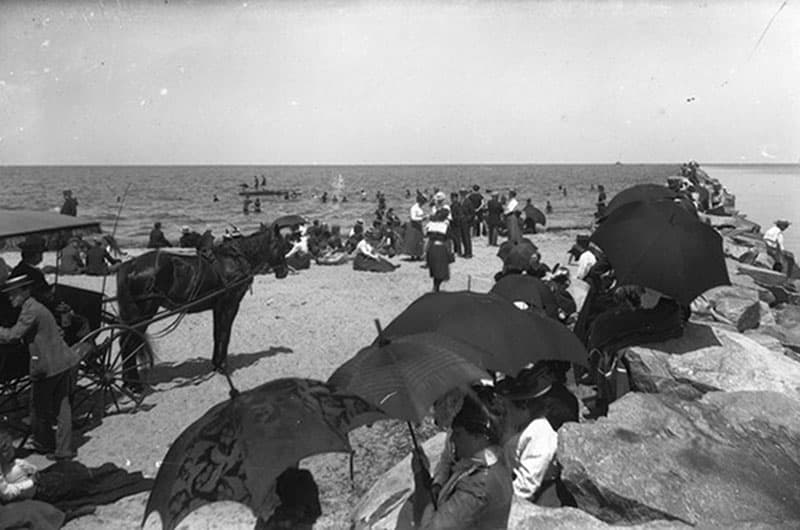~ by Amy Jenness, author of On This Day in Nantucket History, available at Mitchell’s Book Corner ~

The South Wharf bathing house was open for ladies on Wednesday and Saturday afternoons from 1 to 6 pm. The house was open to gentlemen the rest of the week and cost $2 for the season.
In a letter to the editor that September, a writer signed “S.” extolled the virtues of swimming in the ocean. “It is indeed an interesting, if not sublime sight when the waves run high and roll their surges on the shore, to behold man, feeble in body, but capacious in mind, in courage invincible, plunging through the surf and buffeting the proud billows.”
Swimming in the ocean, along with drinking sea water, was believed to cure disease in the 18th century. In 1753, Dr. Charles Russel published The Uses of Sea Water which recommended the use of sea water for healing various diseases, and William Buchan wrote his 1769 book Domestic Medicine advocating the practice. Sea bathing and sea water were advocated with winter considered to be the best time to follow the practice. Buchan’s book was published until 1846 and was translated into many languages. By the 19th century water treatments at hot springs and at the ocean were popular and Nantucket, looking to create a tourist industry, marketed itself as perfect for place for health and rejuvenation.
Etiquette, and beliefs about how to body worked, made sea bathing a private affair for many until the mid 1800s. People remained heavily dressed when they swam and men and women went separately. Bathers also believed the body could not tolerate extreme temperatures. An 1822 item in the Inquirer & Mirror said, “A boy died very suddenly last Monday at Stamford, Con., in consequence of going into the water to bathe, while his blood was overheated, Let this be a caution to parents how they permit their children to bathe in the middle of the day, in the broiling hot sun. Nothing can be more prejudicial to health.”
By the 1860s swimming at the beach was popular as a recreational activity. Charles Hayden opened the Clean Shore Bath House under the Cliff on the North shore. He offered 21 rooms and and said in an advertisement, “every inducement will be offered to make them a place of popular resort.”
In the 1882 book The Island of Nantucket: What it was and what it is: Being a Complete Index offered this assessment, “The bathing facilities of the island are good and include both still water and surf bathing. Good surf bathing can be found only at Sconset and Wauwinet, each of which localities is about seven and one half miles from town. There is a bath house at the Clean Shore which is reached by a road branching from Steamboat Wharf If desired one can get here at all times a warm salt water bath which for certain diseases is considered very beneficial. The price charged for a warm salt water bath is twenty five cents and for an ordinary sea bath twenty cents which includes the use of a room and a bathing suit There are also two bathing establishments at the Cliff the prices for bathing being the same as at the Clean Shore.”
Later a Miss Hayden opened Hayden’s Warm Salt Water Bath Rooms which offered indoor, heated baths full of ocean water (when the tide was high) on the first floor and lodging rooms on the second. Hayden’s Warm Salt Water Baths was first located on North Water Street about where the Nantucket Yacht Club sits today and later moved to Easy Street.
In 1910 Grace Hemingway brought her 11 year old son Ernest to Nantucket for a month and young Ernest swam in the ocean for the first time. He delighted in the swimming at the beach and went every day. His mother preferred the comfort of Hayden’s hot water bath and visited that establishment every day. Later Hemingway would recall his Nantucket adventures with his mother saying, “”I’d go in with the kelp and the horseshoe crabs, and you’d swim in salt water baths.”
In 1890 a new, 50 room bath house opened on the north shore of Coatue. The bathing pavilion included a covered look out for viewing, and the owners planned to moor a large barge there to be used as a floating bath with 120 more rooms as well as diving boards and a “toboggan” slide for swimming in deep water. Patrons would be shuttled from Steamboat Wharf to Coatue by the steamship Coskata.
In 1905 developer Clifford Folger replaced simple bath houses at Jetties Beach with an ornate complex of buildings that included a main building with a covered piazza, a dining room, four apartments on the second floor and two wings (one for men and one for women) that offered 150 bathing rooms. The wings offered changing areas, showers and toilets and patrons could bring their own swim suits or rent one. The main building and one wing of Folger’s bathing pavilion still stand at Jetties Beach.
In 1906, island businessmen built a “Bathing Pavilion,” on Sconset beach. Believed to be the first swimming pool constructed on the island, the pavilion offered heated and cold pools with both salt water and fresh water, as well as bath-houses and showers. The Sconset pavilion existed for about ten years and in 1919 was turned into a residence.